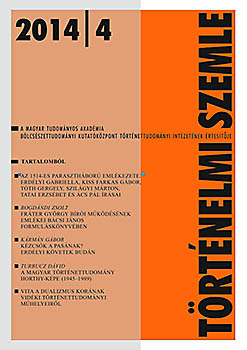A magyar történettudomány Horthy-képe (1945–1989)
The Image of Horthy in Hungarian Historiography (1945–1989)
Author(s): Dávid TurbuczSubject(s): History, Political history, WW II and following years (1940 - 1949), Post-War period (1950 - 1989), History of Communism
Published by: Magyar Tudományos Akadémia Bölcsészettudományi Kutatóközpont Történettudományi Intézet
Keywords: Miklós Horthy; Hungarian historiography; 1945-1989; history;
Summary/Abstract: After 1945 the judgement of Miklós Horthy went through a radical transformation with regard to the preceding cult which could not fail to influence Hungarian historiography. In the period between 1945 and 1989 three distinctive interpretations concerning Horthy can be identified in the Hungarian historical scholarship. The efforts of bourgeois historians in the coalition period failed, on account of the political situation and the actual positions of power, to influence effectively the prevailing image of Horthy. The denunciating narrative, however, which at first emerged as part of communist party propaganda, played as a matter of fact a dominant, and, under the Rákosi regime, hegemonic infl uence. This narrative aimed to depict the Horthy period and the governor himself in the most unfavorable terms possible. It presented the whole period between 1919 and 1944 as a basically homogeneous era, the all-time nadir of Hungarian history, when nothing but damnable things happened. All the merits of Horthy were negated, and his role and responsibility were judged without the slightest empathy. Horthy was consequently turned into a scapegoat, one of the darkest figures of Hungarian history. One of the long-term consequences of the 1956 revolution was to bring about a change in this respect: with the easing of the pressure on the historical science under the consolidated Kádár regime, the assessment of the Horthy regime gradually lost its legitimizing role. Although the denunciating narrative by no means disappeared, it lost first its hegemonic, and then its dominant position. Thank to sustained research, more nuanced, strictly scientific approaches to the life and political activities of Horthy could find their way to the press, which were increasingly free of all propagandistic purposes. One of the corollaries of this process was specialization and the consequent rejection of the denunciating narrative: relying on each other’s works, the scholars aimed at offering a more balanced image of Horthy, which, in turn, changed the vocabulary itself by removing definitively the phrases routinely used in the 1950s. In addition, the arguments and explanations applied likewise changed and became more complex.
Journal: Történelmi Szemle
- Issue Year: 2014
- Issue No: 04
- Page Range: 663-688
- Page Count: 26
- Language: Hungarian

